After the 2-0 win in Belgrade, Red Star Belgrade went to Finland for the second leg of the UEFA Champions League qualifiers second round against HJK Helsinki. The Serbian team was the favourite in this duel, but struggled to perform on their highest level so they lost the game 2-1, but managed to pass through the next round due to the result from the first match.
Even though they won on the home turf, Toni Koskela’s boys weren’t good enough to overpower their rivals in altogether, so the Red and Whites succeeded in their intention to come closer to the group stage of the prestigious competition.
This tactical analysis will show you how Vladan Milojević’s men climbed to the third stage of the qualifiers although they didn’t play the way they accustomed us to.
Lineups
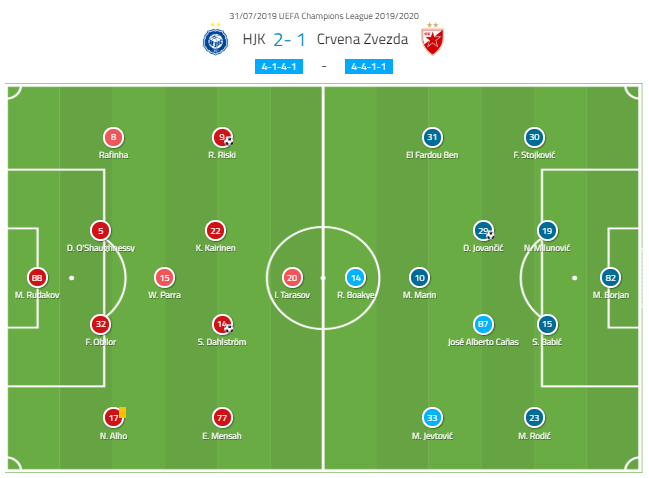
HJK set their tactics in the 4-3-3 formation, that transformed to 4-2-3-1 with focus on the possessional play and movements in the final third of the pitch. The main attacking threats in the team were Riku Riski and Evans Mensah who played as wingers, with the support of Sebastian Dahlstrom who was the most offensive midfielder in their lineup.
Red Star was set in their usual 4-2-3-1 formation that went through a lot of variations because of the freedom that their key players have in the offensive parts of the field. Marko Marin, Richmond Boakye and El Fardou Ben were the main attacking forces for Milojević’s team, who surprised the opponents with starting Aleksandar Jevtović over Mirko Ivanić on the left-wing.
The Serbian team’s density
The home team went into the match with a clear approach – they were fully offensively oriented to overturn the result from Belgrade in their favour. The Finns tried to control the game through possession but struggled to create dangerous attacks because of Red Star’s organised defensive structure.
Serbian champions were disciplined when the ball was in their opponents’ feet and were set in the dense central block in the 4-4-2 shape. They let HJK play around their arranged setup but shut all of the passing lanes to the attackers of their team.
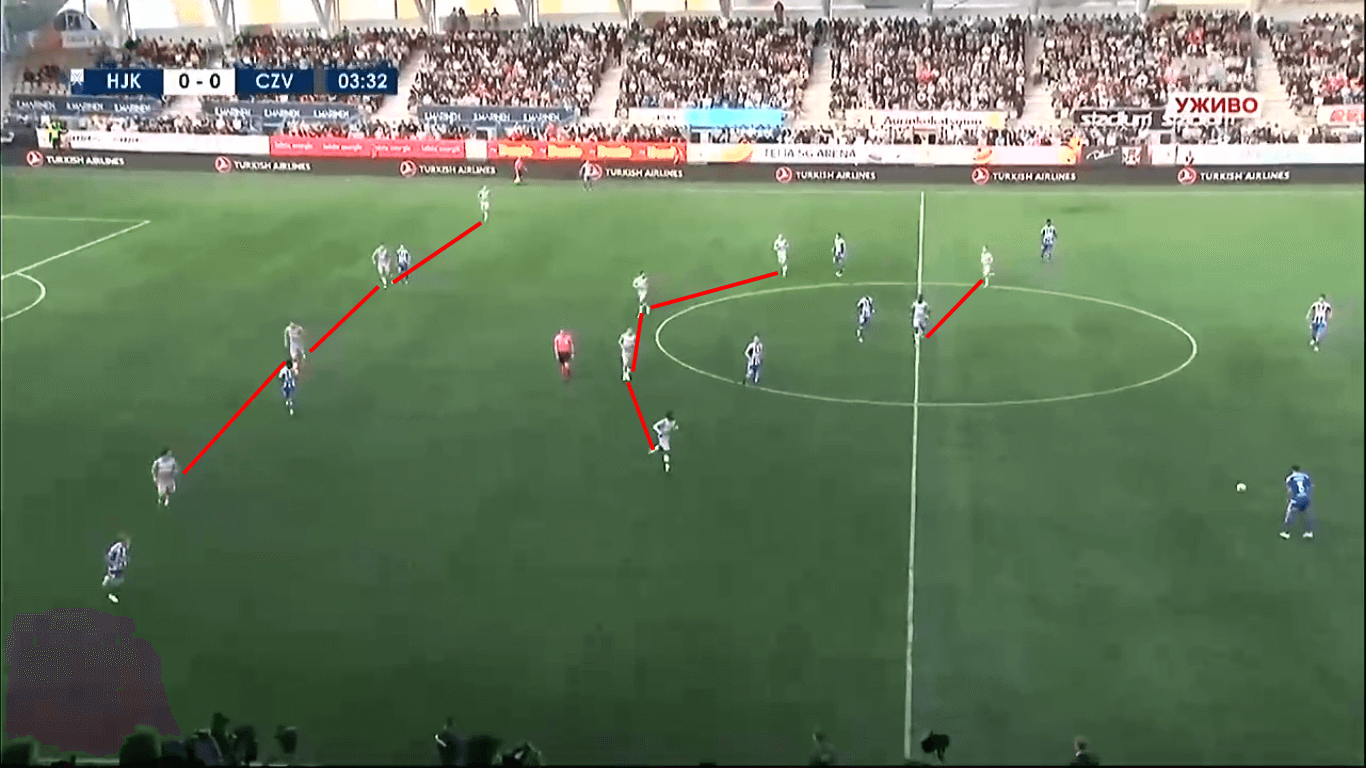
Visitors used this type of structure in most cases in the game and forced the opposition to play it wide due to a huge density of players in the central and inner corridors. Throughout the game, they managed to close down the key players of Koskela’s team and limited them to get the ball in tight areas with a lot of guards on them.
Crvena Zvezda’s players were quite mobile in their defensive tasks and were providing support to each other in every part of the pitch. They tended to create surplus situations, out of their central block which tended to drop lower, over the player in possession to win the ball back.
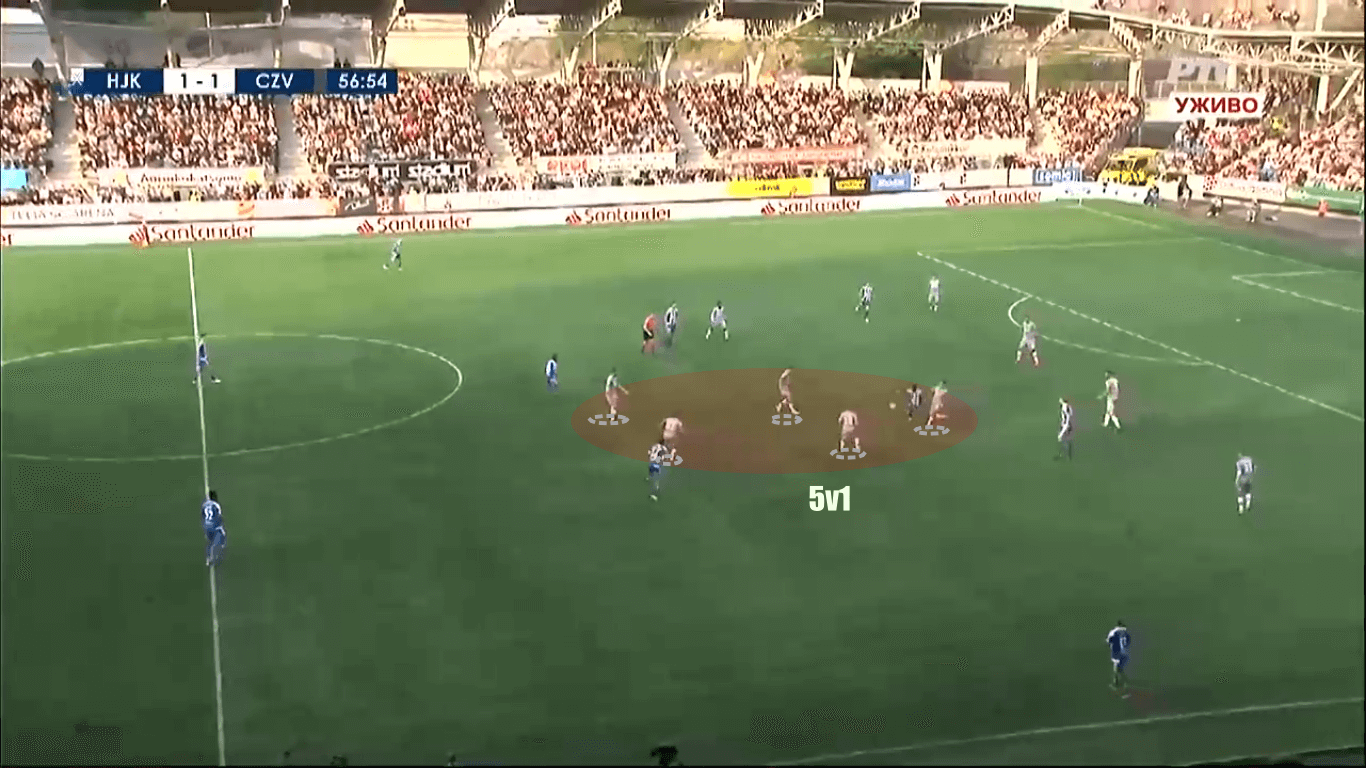
As we can see in the picture, Milojević’s men created a dead-end position for the HJK player with their good movement and forming of the “5v1” scenario which led them directly to regain the possession.
Their defensive structure also went through transformations. Even though they defended in the 4-4-2 in a majority of the match, in some cases they have fallen back in the 5-3-2 with Miloš Rodić, who was the left-back, moving more centrally and becoming a third centre-back, and Jevtović dropping down to play as a left full-back.
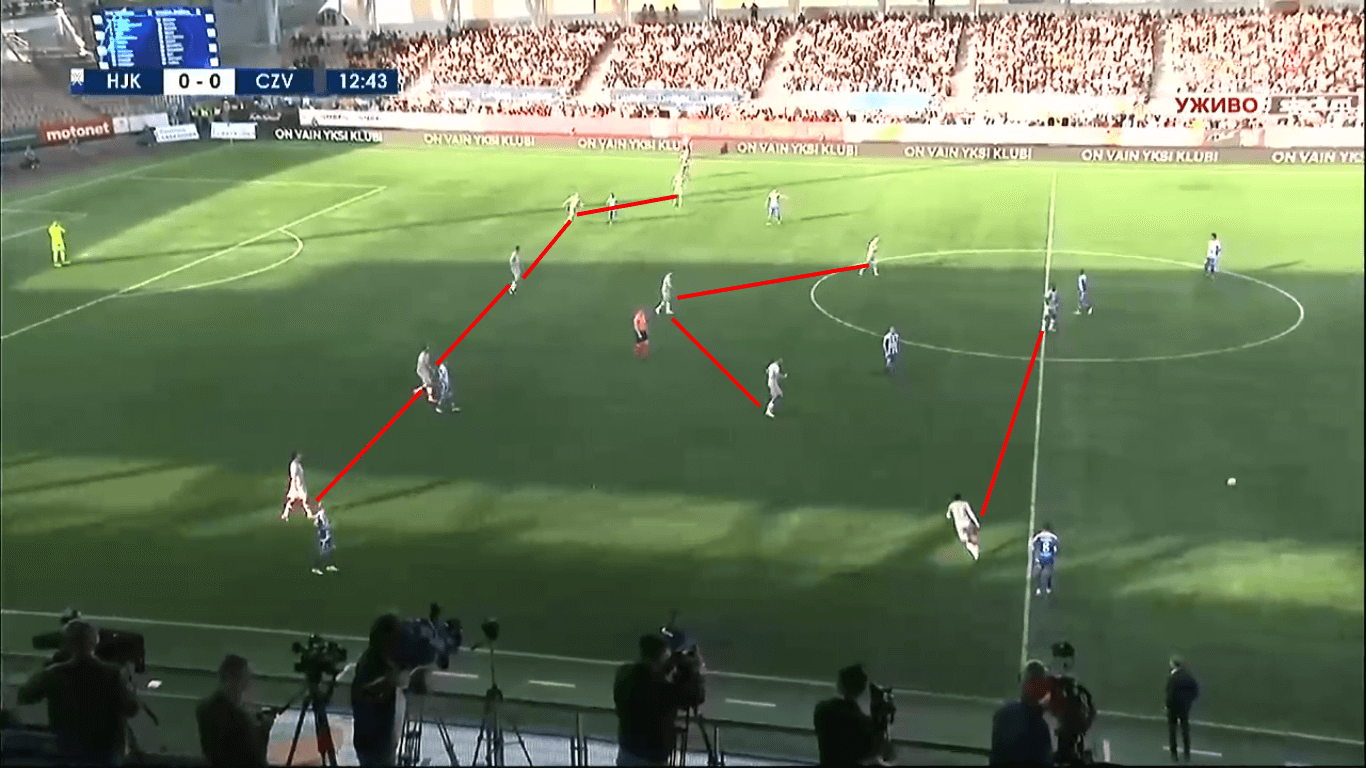
The Finns had the control of the game but they didn’t manage to get in bigger chances because of their lack of creativity in the final third and because of Red Star’s good defensive structure, which was probably the key to their aggregate win.
HJK’s offensive rotations
The possessional play didn’t go for the home team as they expected. They tried to „bully“ the opposition moving the ball around and around, but didn’t find the way to break through the lines with ease.
Zvezda cut their passing lanes and they were forced to move the ball to the flanks, circling the defensive block. The key players of their team – the two wingers – were playing basically as an inside forwards and were pretty easy to guard, but that opened the space for the full-backs on the flanks to exploit it.
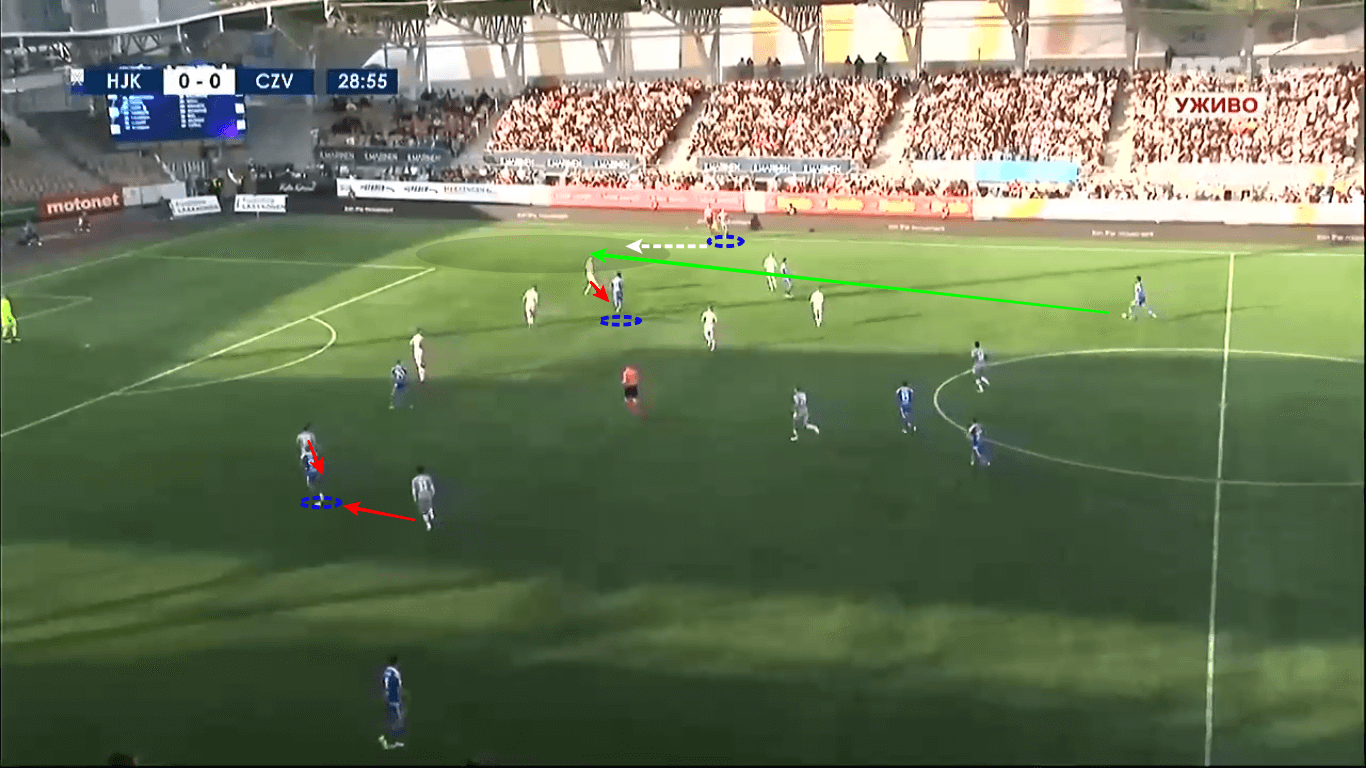
In the picture above, Mensah and Riski cut inside to find the room in the half-spaces but were closed down by the Serbian team’s defenders. The focus opposition had on them opened the passing lane for the right-back, and similar situations repeated throughout the game on both of the flanks.
Since they weren’t that dangerous from those positions, they needed to come up with some different rotations to get to the chances that will bring them closer to overturning the result. Their wingers, who were probably the most active players in their team, searched for a free room in all parts of the pitch in the final third, rotating with the lone striker and making run-ins from both flanks and half-spaces.
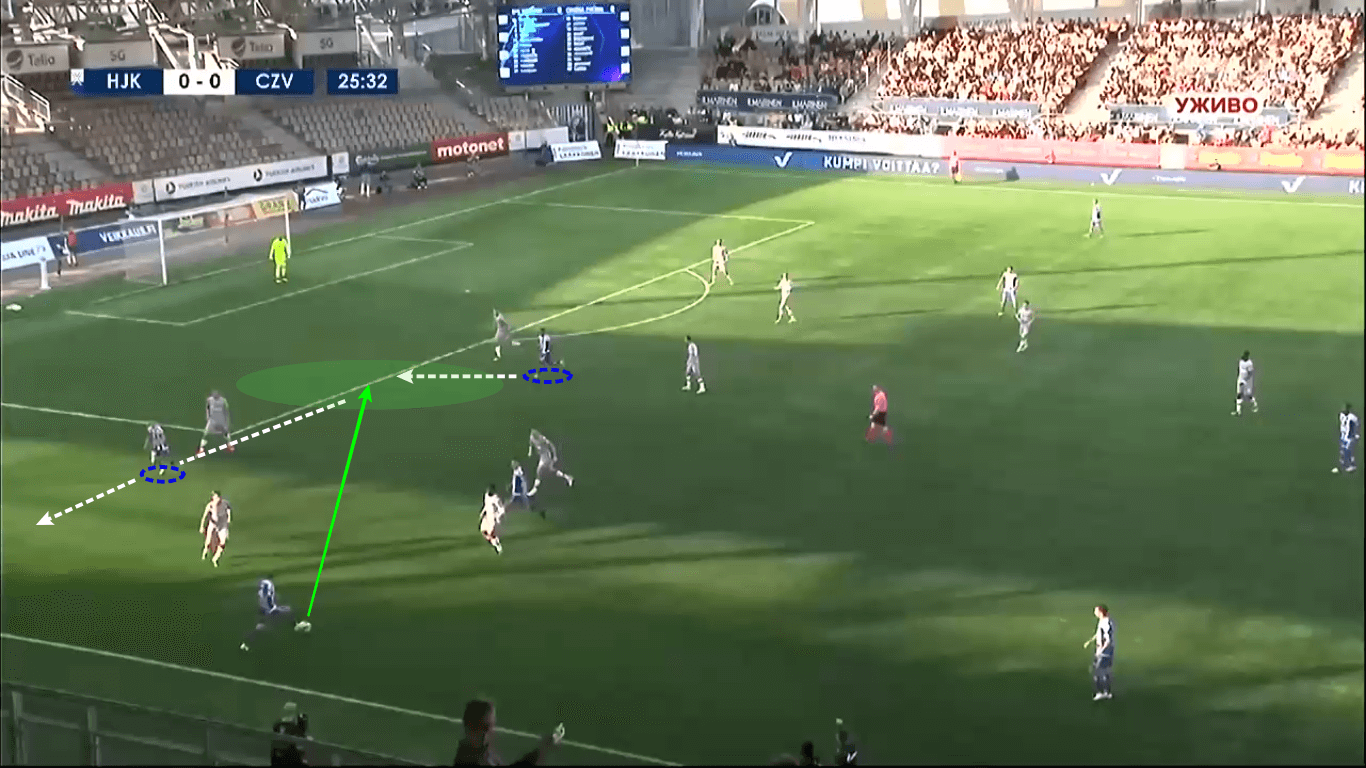
Mensah and Riski communicated well with their strikers – firstly Ivan Tarasov, and after that Tim Vayrynen – and used the space they freed to cut inside and make twists in front of Milan Borjan’s goal. The two wingers rotated also between each other, making one of them go deeper and play as a second striker, while the other tried to find the gaps between the lines in the opponent’s defensive structure.
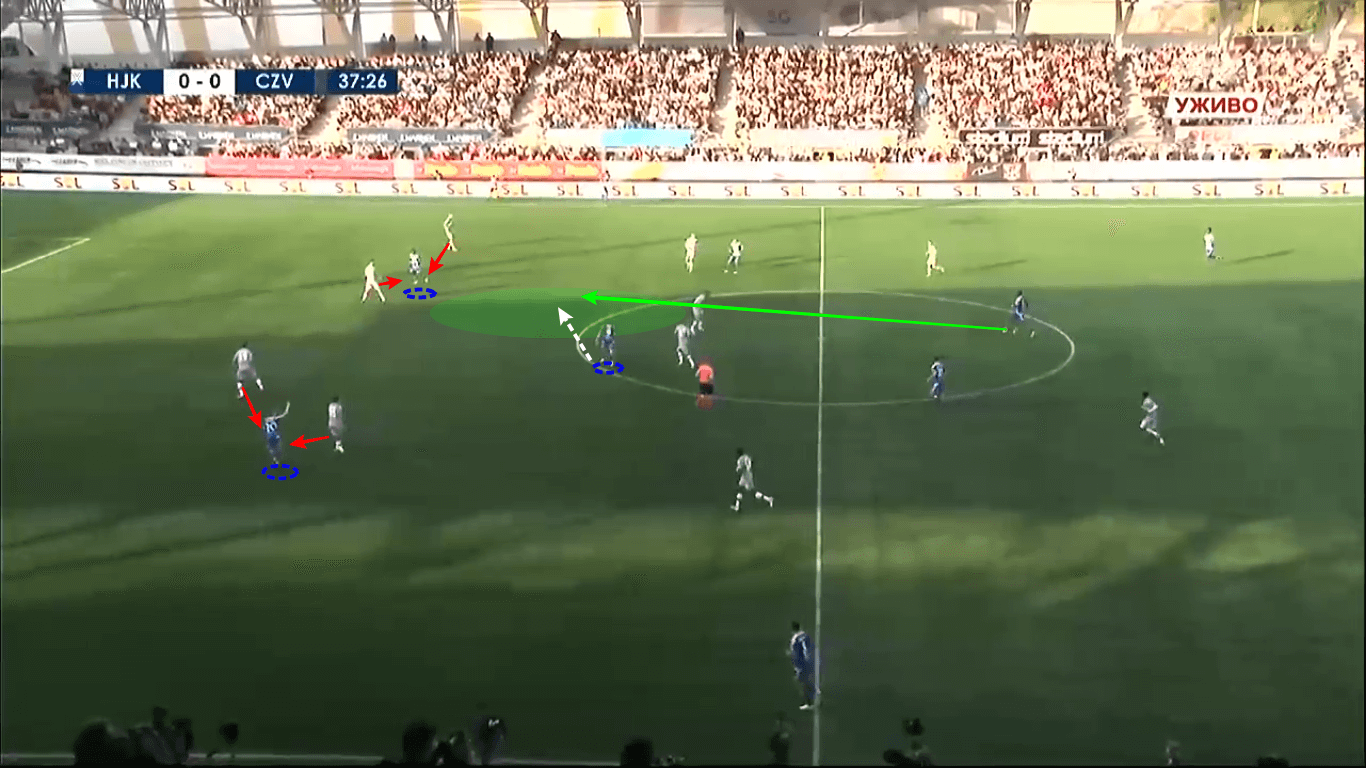
All of those situations, even though they were happening frequently, didn’t threaten the Red Star’s net since the four defenders of their team did a good job being the last line through which HJK players needed to break. The Finns got their goals and their win because of the poor passes of Zvezda’s players and punished them for their mistakes, but it wasn’t enough to win it in aggregate.
Red Star’s run-ins and overloads
The visitors didn’t play in the manner that they used to in the last season and their last few matches. Key guys such as Ben and Marin weren’t that noticeable and didn’t perform at their highest level, but they helped their team with the moments of brilliance and individual qualities.
Milojević oriented his tactics more to protect the win from the first leg than to secure another in this match, but his team had more opportunities than the opposition. His team continued to play their half-space game in the attacking parts of the pitch, but HJK knew how to defend the most dangerous players from the away team. The defensive orientation of Koskela’s men freed the room for Red Star’s full-backs to overlap and attempt crosses.
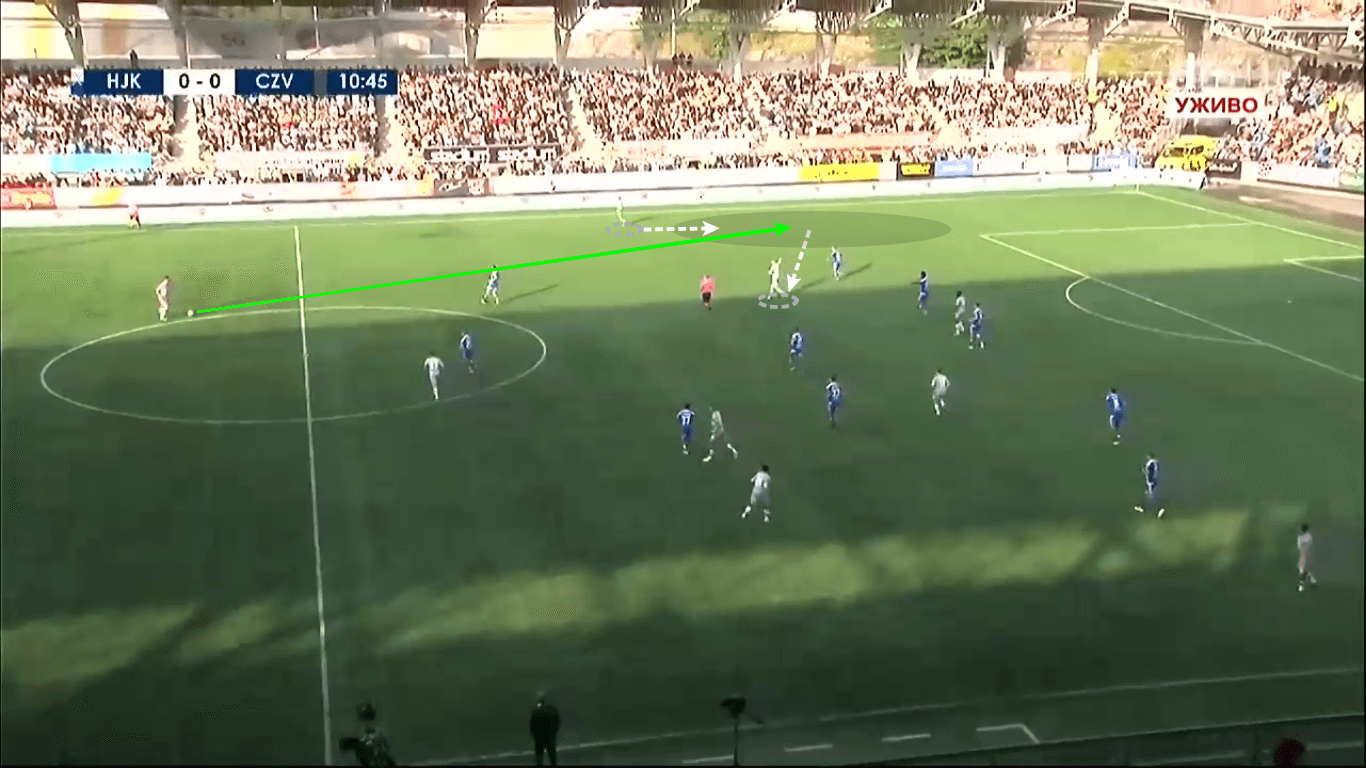
As it is shown, Jevtović’s inside moving emptied the room for Rodić on the left-handed side and set him in position from which he could send the ball into the box. They also tried to get to crossing positions trying to create an overload on one side and isolation on the other, which they did quite good usually making “1v1s” for Marin or Jevtović on next to the left sideline.
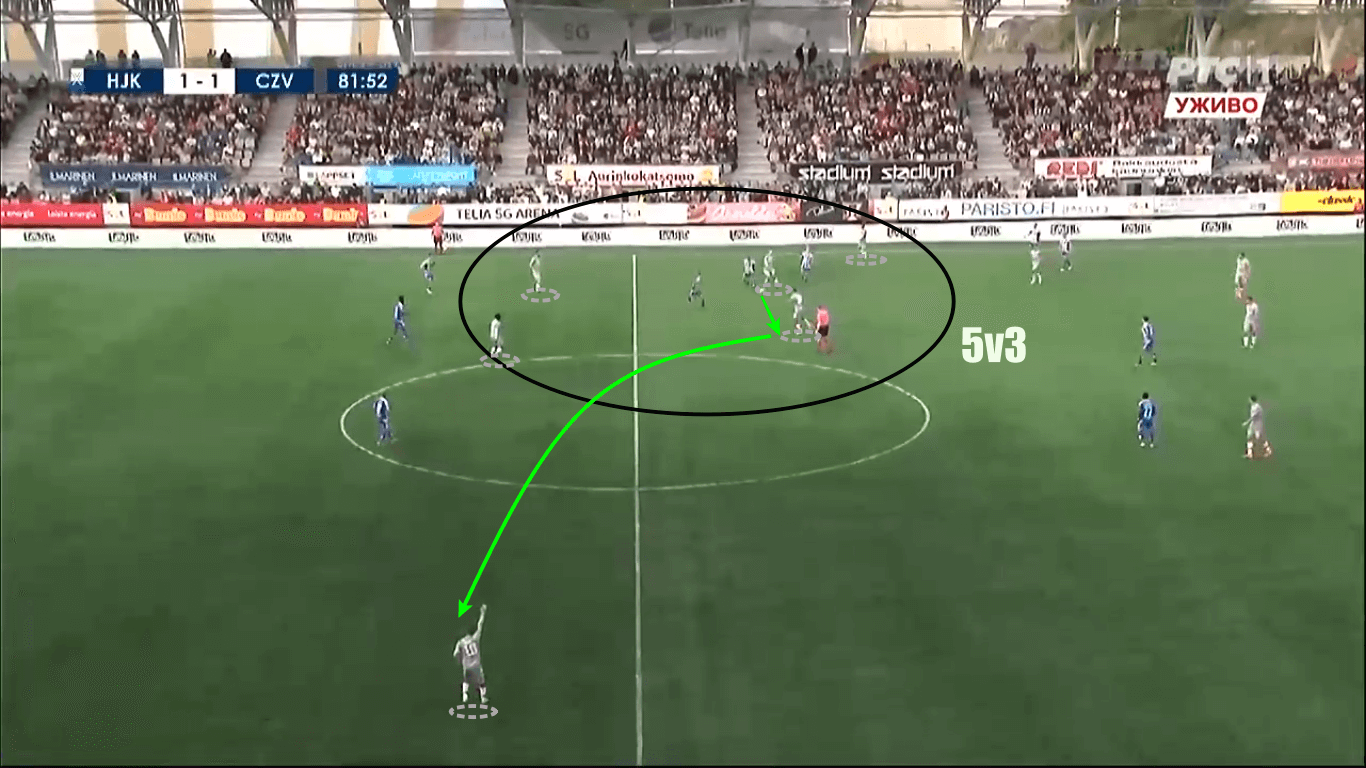
The Serbian champions had their chances out of those scenarios but didn’t manage to score from them so they focused on the run-ins from the second line, performed mostly by the holding midfielders.
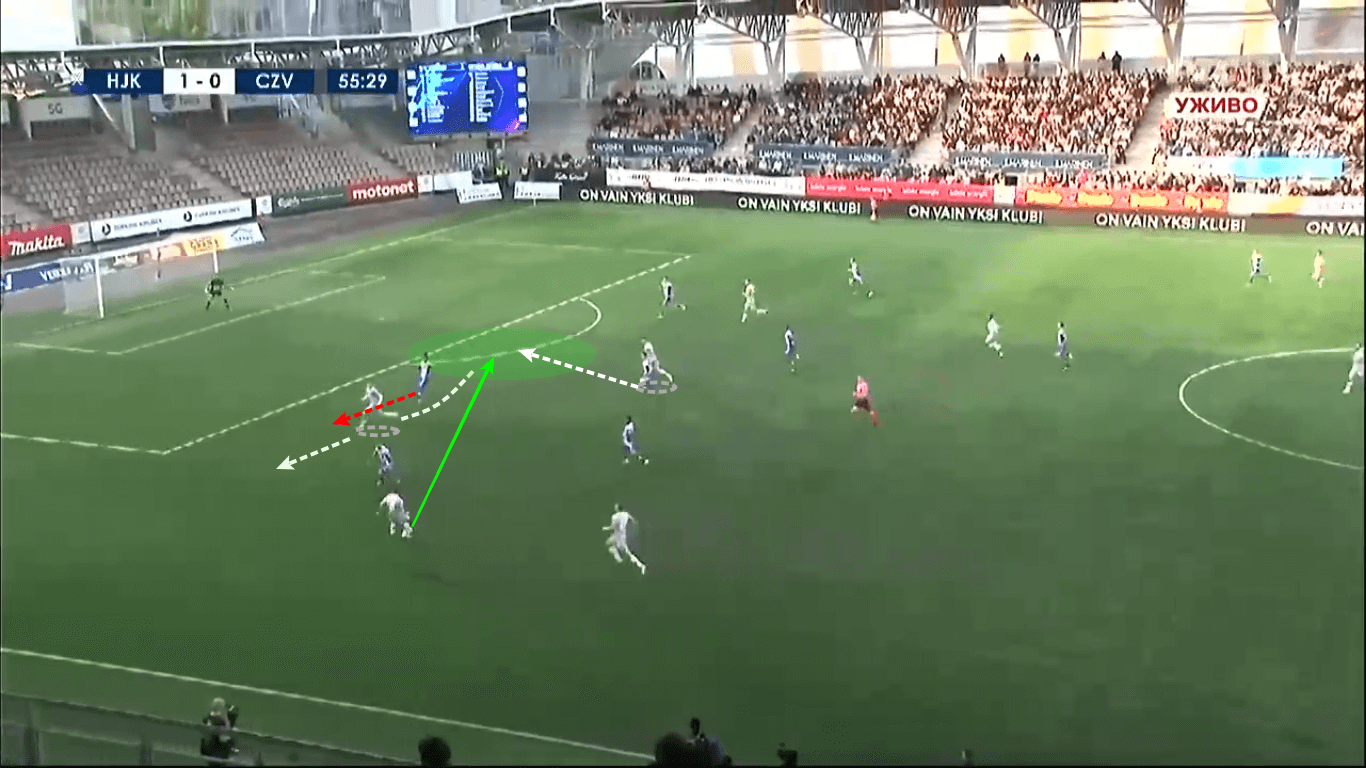
Marin was constantly under pressure and guarded by more than one player which forced him to ask for the ball lower and wider. The focus HJK’s players had on him freed the room for the other, in theory, less dangerous, Zvezda’s players to get into chances to score.
Dušan Jovančić and Jose Alberto Canas used those spaces nicely and were time to time threat for the Finns. One of those situations went all the way through for the visitors since they scored a goal out of it and basically secured the spot in the third round of the UCL qualifiers.
Conclusion
Red Star got luckier in this two-legged duel and although they didn’t perform on their highest possible level, they succeeded in going into the next round. Milojević’s boys were focused on defending in this match but struggled to keep a clean sheet due to a bad decision of their defenders, mostly of Filip Stojković who was the weakest link of their team.
The visitors, who were the favourites, lived up to expectations in terms of the aggregate result but weren’t playing well as expected, as it is shown in this analysis. In the next round, they will face Copenhagen who overpowered TNS and that will be a tough fixture for Crvena Zvezda if they continue to perform in the manner they did in this European campaign.
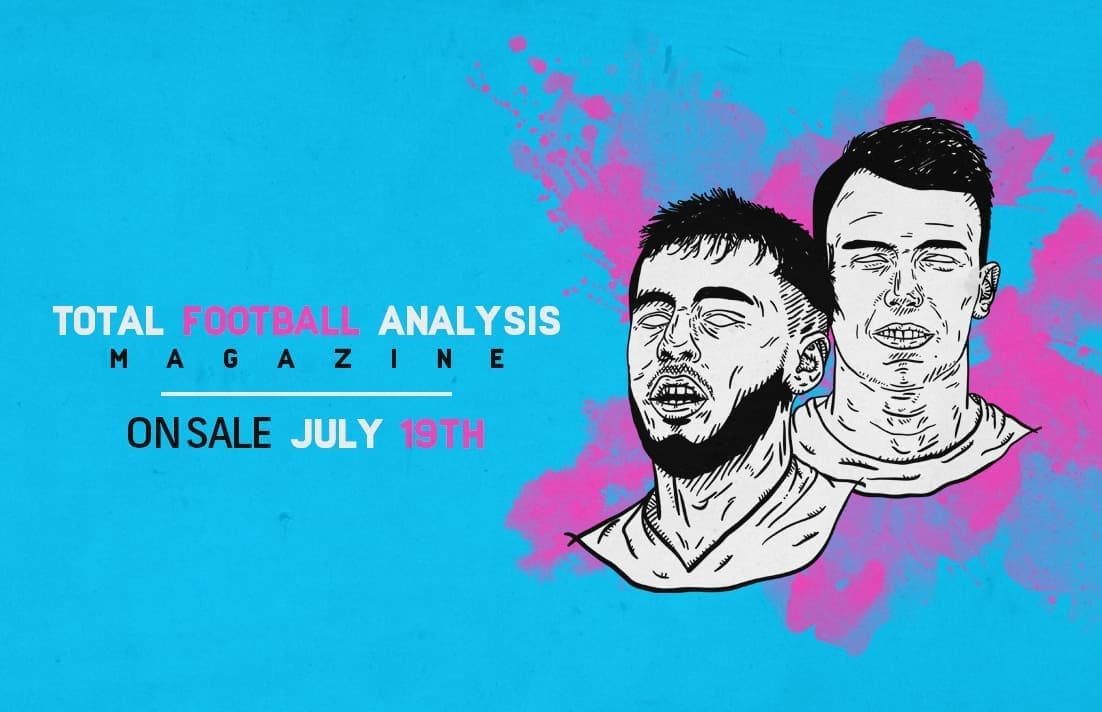
If you love tactical analysis, then you’ll love the digital magazines from totalfootballanalysis.com – a guaranteed 100+ pages of pure tactical analysis covering topics from the Premier League, Serie A, La Liga, Bundesliga and many, many more. Buy your copy of the July issue for just ₤4.99 here, or even better sign up for a ₤50 annual membership (12 monthly issues plus the annual review) right here.

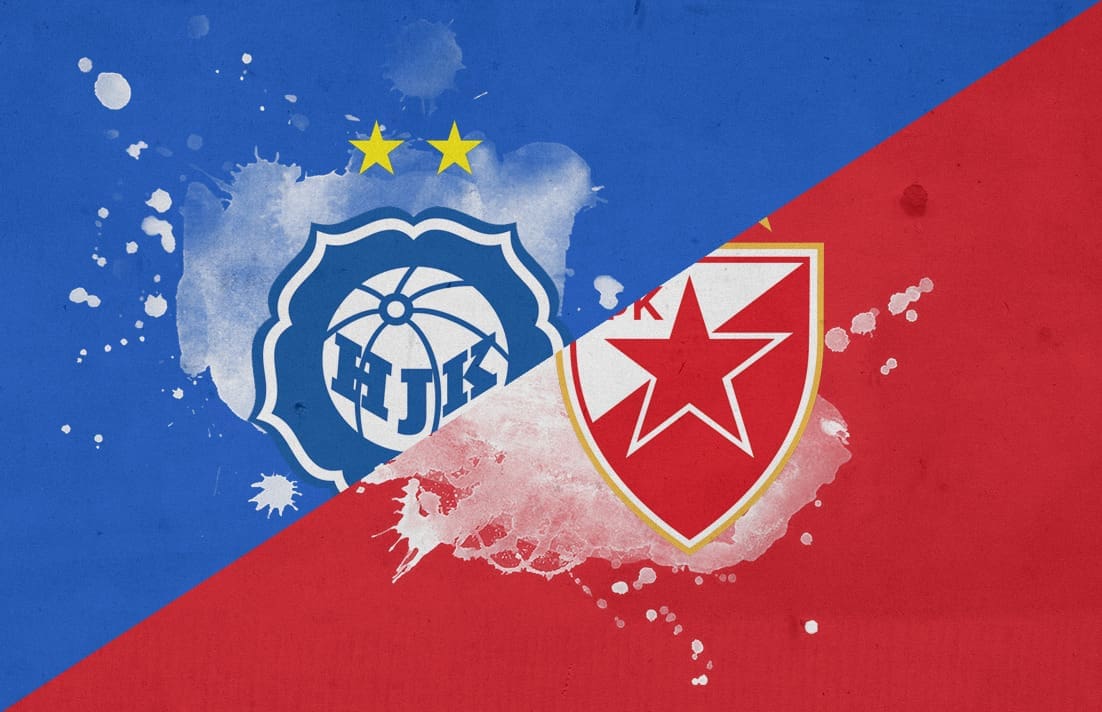



Comments